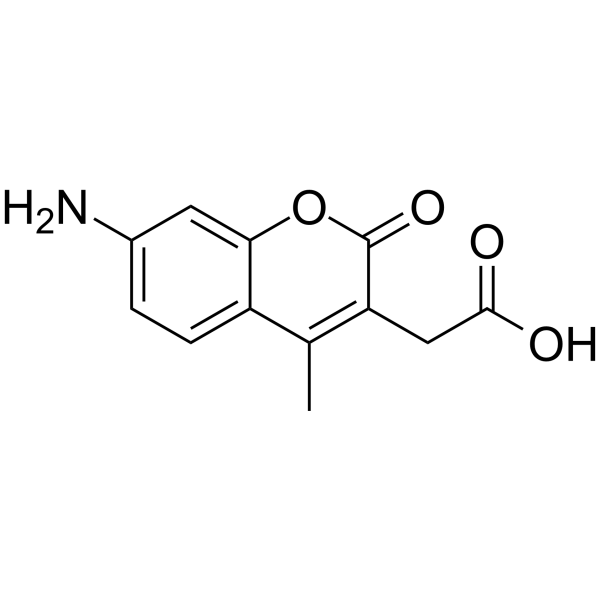7-Amino-4-methylcoumarin-3-acetic acid

7-Amino-4-methylcoumarin-3-acetic acid structure
|
Common Name | 7-Amino-4-methylcoumarin-3-acetic acid | ||
|---|---|---|---|---|
| CAS Number | 106562-32-7 | Molecular Weight | 233.22000 | |
| Density | 1.391g/cm3 | Boiling Point | 512.2ºC at 760mmHg | |
| Molecular Formula | C12H11NO4 | Melting Point | N/A | |
| MSDS | Chinese USA | Flash Point | 263.6ºC | |
| Symbol |

GHS07 |
Signal Word | Warning | |
|
Using droplet-based microfluidics to improve the catalytic properties of RNA under multiple-turnover conditions.
RNA 21(3) , 458-69, (2015) In vitro evolution methodologies are powerful approaches to identify RNA with new functionalities. While Systematic Evolution of Ligands by Exponential enrichment (SELEX) is an efficient approach to generate new RNA aptamers, it is less suited for the isolati... |
|
|
Adaptation by the collecting duct to an exogenous acid load is blunted by deletion of the proton-sensing receptor GPR4.
Am. J. Physiol. Renal Physiol. 309 , F120-36, (2015) We previously reported that the deletion of the pH sensor GPR4 causes a non-gap metabolic acidosis and defective net acid excretion (NAE) in the GPR4 knockout mouse (GPR4-/-) (Sun X, Yang LV, Tiegs BC, Arend LJ, McGraw DW, Penn RB, and Petrovic S. J Am Soc Ne... |
|
|
Basal membrane complex architecture is disrupted during posterior subcapsular cataract formation in Royal College of Surgeons rats.
Mol. Vis. 20 , 1777-95, (2015) Previous studies detailing the development of posterior subcapsular cataracts (PSC) in Royal College of Surgeons (RCS) rats have shown that aberrant fiber-end migration underlies the structural compromise. This investigation was conducted to examine the distr... |
|
|
Adult neural precursor cells from the subventricular zone contribute significantly to oligodendrocyte regeneration and remyelination.
J. Neurosci. 34(42) , 14128-46, (2014) Parenchymal oligodendrocyte progenitor cells (pOPCs) are considered the principal cell type responsible for oligodendrogenesis and remyelinaton in demyelinating diseases. Recent studies have demonstrated that neural precursor cells (NPCs) from the adult subve... |
|
|
Dynactin functions as both a dynamic tether and brake during dynein-driven motility.
Nat. Commun. 5 , 4807, (2014) Dynactin is an essential cofactor for most cellular functions of the microtubule motor cytoplasmic dynein, but the mechanism by which dynactin activates dynein remains unclear. Here we use single molecule approaches to investigate dynein regulation by the dyn... |
|
|
Reactivity of lysyl residues on the (Ca(2+)-Mg2+)-ATPase to 7-amino-4-methylcoumarin-3-acetic acid succinimidyl ester.
Biochemistry 32 , 356, (1993) The (Ca(2+)-Mg2+)-ATPase of sarcoplasmic reticulum was labeled with the succinimidyl ester of 7-amino-4-methylcoumarin-3-acetic (AMCA). Although a large number of residues were labeled, it was found that Lys-492 was labeled preferentially at pH values between... |
|
|
Core RNA polymerase from E. coli induces a major change in the domain arrangement of the sigma 70 subunit.
Mol. Cell. 3(2) , 229-38, (1999) Luminescence resonance energy transfer measurements were used to show that binding of E. coli core RNA polymerase induced major changes in interdomain distances in the sigma 70 subunit. The simplest model describing core-induced changes in sigma 70 involves a... |
|
|
Immunodominance of a low-affinity major histocompatibility complex-binding myelin basic protein epitope (residues 111-129) in HLA-DR4 (B1*0401) subjects is associated with a restricted T cell receptor repertoire.
J. Clin. Invest. 100(2) , 339-49, (1997) The pathogenesis of multiple sclerosis (MS) is currently ascribed in part to a T cell-mediated process targeting myelin components. The T cell response to one candidate autoantigen, myelin basic protein (MBP), in the context of HLA-DR15Dw2, has been previousl... |
|
|
Dipeptide uptake by adenohypophysial folliculostellate cells.
Am. J. Physiol. 271(1 Pt 1) , C210-7, (1996) Dipeptide uptake was studied in primary cultures from rat anterior pituitaries by use of radiolabeled carnosine and the fluorescent dipeptide derivative beta-Ala-Lys-N epsilon-AMCA (AMCA is 7-amino-4-methylcoumarin-3-acetic acid). Fluorescence microscopic stu... |
|
|
Two- and three-color immunofluorescence using aminocoumarin, fluorescein, and phycoerythrin-labelled antibodies and single laser flow cytometry.
Cytometry 12(6) , 537-44, (1991) Antibodies coupled to 7-aminocoumarin (AMCA) emit a bright blue fluorescence under ultraviolet (UV) excitation and are therefore ideal for three-color immunofluorescence (IF) with fluorescein (FITC) and phycoerythrin (PE) labeled reagents; however, due to the... |